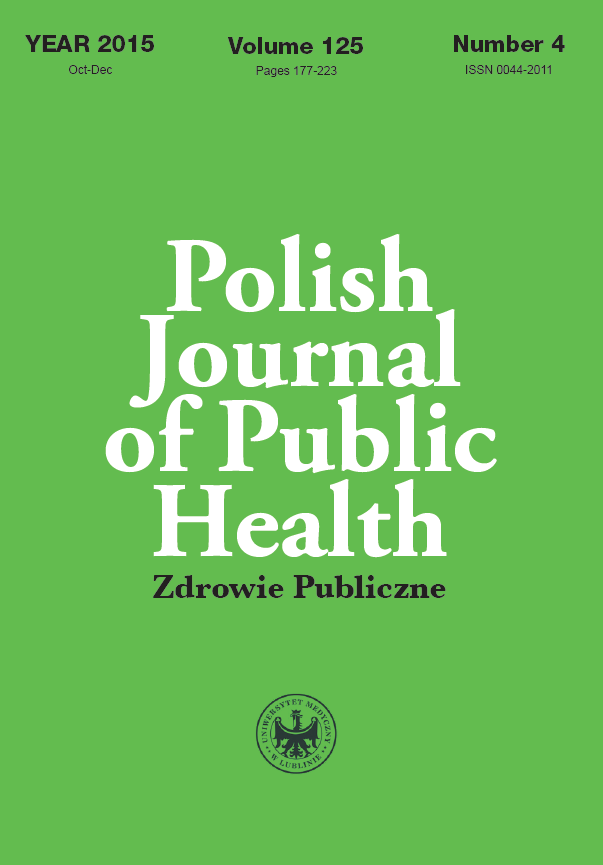Adaptation of children with illnesses of the motor organs to hospital conditions
DOI:
https://doi.org/10.1515/pjph-2015-0058Keywords:
reintegration, hospitalized child, illnesses of the motor organsAbstract
Introduction. It seems that the society should accept the legal and moral responsibility and the care over the injured individuals due to their health problems. Medical staff, doctors and nurses play a major role in the care of children, it is them who are in a direct contact with them in the course of the stay in hospital. The reaction of a child, as an exceptional patient, is quite varied as for the stay in different institutions. Patience, warmth and understanding are features which are necessary in the adaptation to conditions of the treatment. The medical professionals somehow replace parents and care providers, and create home-like environment for these children which means they can always count on help and understanding.
Aim. The purpose of this research was to portray children in hospital as well as their stance toward the current situation, expectations, pleasures and aversions.
Material and methods. The authors of the study examined 20 patients of a surgical clinic, both girls and boys. They applied the method of the diagnostic survey. The research was done using theinterview technique based on contents of unfinished sentences. 12 girls and 8 boys took part in the examination.
Results and conclusion. The examinations reveal that in order to combat negative feelings and overcome loneliness amongill children, hospitals should prolong the visiting time for family and friends and locate patients in rooms according to age, sex or disease. Delivering the greater scope of information provides a sense of security to children and hence has a positive effect to the adaptation to hospital settings.
References
1. Arusztowicz B, Bakowski W. Dziecko kalekie jakiego nie znamy. Warszawa: WSP; 1999.
2. Gasiulowa A. Wrażliwość empatyczna dzieci z dysfunkcją narządu ruchu a ich środowisko rodzinne. Bydgoszcz: WSP; 2003.
3. Bogusz J. Encyklopedia dla pielęgniarek. Warszawa: PZWL; 2008.
4. Aamer N, Abhijit B, Sanjeev S, et al. Fernandes. Complications of Elastic Stable Intramedullary Nailing for treating paediatric long bone fractures. J Orthop. 2013;10(1):17-24.
5. Jolly J. Inna strona pediatrii. Poradnik codziennej opieki nad chorymi dziećmi. Warszawa: PZWL; 2007.
6. Hedström EM, Svensson I, Bergström U, Michno P. Epidemiology of fractures in children and adolescents. Acta Orthop. 2010;81(1):148-53.
7. Kowalik S. Wybrane psychospołeczne problemy niepełnosprawności i rehabilitacji. In: H. Sęk. Społeczna psychologia kliniczna. Warszawa: PWN; 2003.
8. Kozakiewicz W, Brzózka B. Biblioteka szpitalna dla pacjentów. Poradnik. Warszawa: SBP; 2000.
9. Kulczycki M. Psychologiczne problemy człowieka chorego. Wrocław: OSS; 2012.
10. MacMahon RA.Poradnik chirurgii dziecięcej. Warszawa: PZWL;1990.
11. Rembowski J. Metoda projekcyjna w psychologii dzieci i młodzieży. Warszawa: PWN; 2006.
12. Sękowska Z. Pedagogika w lecznictwie. Warszawa: PZWL; 2006.
13. Sękowska Z. Wprowadzenie do pedagogiki specjalnej. Warszawa: WSPS; 2008.
14. Bianba, Berntsen S, Andersen LB, et al. Exercise Capacity and Selected Physiological Factors by Ancestry and Residential Altitude: Cross-Sectional Studies of 9–10-Year-Old Children in Tibet. High Alttude Med Biol. 2014;15(2):162-9
15. Pilch T. Zasady badań pedagogicznych. Warszawa: ŻAK; 2005.
Downloads
Published
Issue
Section
License
Copyright (c) 2016 Polish Journal of Public Health

This work is licensed under a Creative Commons Attribution-NonCommercial-NoDerivatives 3.0 Unported License.


